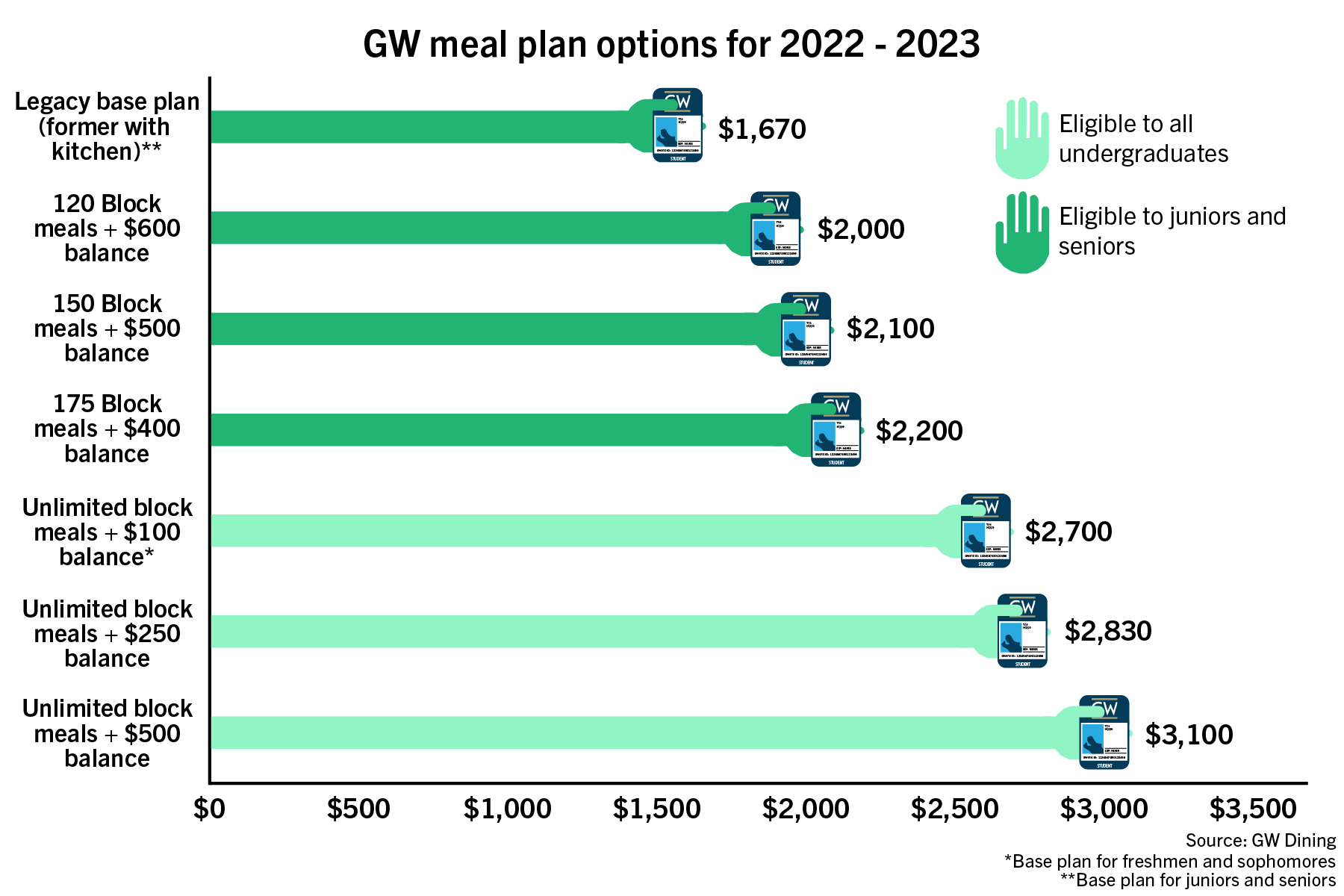Nearly 1,000 people have signed a petition calling on officials to keep GW’s current meal plan open to all students after this academic year, citing concerns about higher costs and fewer options under the dining system that the University will roll out in the fall.
The new dining system will open three dining halls in District House and Thurston and Shenkman halls, where students can receive “all-you-can-eat” meal access with a smaller declining GWorld balance that they can use at local vendors. GW will require freshmen and sophomores to purchase one of three meal plans starting at $2,700, which includes unlimited dining hall swipes and varying GWorld balances, while incoming juniors and seniors have the option to continue with the traditional meal plan completely composed of a declining GWorld balance.
More than 10 of the petition’s signatories said in interviews that they are concerned the new meal plan will leave them with lower-quality food, higher costs, reduced options and fewer groceries to put their kitchens to good use. Officials said when they unveiled the plan in August that the new dining halls will offer a variety of diverse foods, address food insecurity and help foster community in future years.
Freshman Nicole Dobrin, who created the petition, said she wants to cook much of her own food in the future, but the decrease in students’ GWorld balances will make it more difficult to grocery shop consistently throughout the school year. Dobrin said students will be less incentivized to use their in-room kitchens, which appear in more than 15 residence halls on campus, because they will have less GWorld money for groceries.
The current dining system, an open dining plan that requires students to use dining cash to purchase food from grocery stores and restaurants, has faced years of criticism from students for not providing them with enough money for food throughout the semester.

Nicholas Anastacio | Graphics Editor
Dobrin, a human services and social justice major, said she’s frustrated that members of the current freshman class could not contribute to officials’ decision to launch the new dining system last August, and the petition is a way for their voices to be heard.
Dobrin said she has not submitted the petition to officials.
“Our class wasn’t even allowed to have a say in any of this, they just decided this before we got here,” Dobrin said.
University spokesperson Crystal Nosal did not return a request for comment.
Freshmen and sophomores must select one of three meal plans with a declining GWorld balance of $100, $250 or $500 for the semester, according to the University’s website. These meal plans are attached to a total cost of $2,700, $2,830 and $3,100 respectively, GW’s website states.
Students with a kitchen currently pay $1,617 per semester for their meal plan, and those without a kitchen pay $2,519 each semester – totals that spent entirely at GWorld vendors.
In addition to meal plans with unlimited swipes, juniors and seniors also have the option to purchase swipes in “blocks” of 120, 150 and 175, which come paired with $600, $500 and $400 of GWorld, respectively.
Vidya Muthupillai, a freshman who is undeclared, said she’s concerned she won’t have enough GWorld to spend on groceries under the new dining system.
“We pay a lot of money to come here to GW so it’s frustrating to have to pay more money but not get the same flexibility and options that we already have available,” Muthupillai said.
Freshman Tia Hood – who has Celiac disease, an immune reaction to eating gluten – said she wants the University to include freshmen and sophomores in the option to continue using the University’s traditional dining plan that does not include meal swipes, which is restricted to juniors and seniors. She said if officials are unable to expand this option, they should at least provide sufficient funds for students with allergies to purchase groceries.
“I would like to either see them keep the legacy option for second-years as well as third- and fourth-years as an option or give people with allergies the option to opt out of the dining plan altogether and just buy our own groceries with the money we would use on the food plan,” Hood said.
Hood said she’s concerned the dining halls may not be able to provide meals that fit with her dietary restrictions, especially due to concerns of cross-contamination in dining hall kitchens.
“Unless they are 100 percent perfect with making food gluten-free, it is going to be an issue for me to eat at the new dining halls,” Hood said.
The nearly 700 students living on the Mount Vernon Campus were required to participate in the early stages of GW’s new dining plan this year called the Pelham Plan, which grants students 112 meal swipes of all-you-can-eat meal access at The Eatery at Pelham Commons alongside about $1,620 to be used at other GWorld vendors each semester.
Students have expressed concerns about food quality and hours of operation at the Vern’s dining hall, operated by Chartwells Higher Education, which will operate the new dining halls in Foggy Bottom this fall. Chris Koppi, a freshman fine arts major, said they prefer eating in Foggy Bottom because of the proximity to classes and limited hours of Pelham Commons, leaving several meal swipes unspent.
“I spend the majority of my money eating on Foggy Bottom, which meant that last semester, I had like 60 swipes leftover, which is almost half,” Koppi said.
Koppi said there are options for vegan and vegetarian students at Pelham Commons, but they lack diversity and choice with a limited number of gluten-free options compared to other meals.
“Technically, they check all the boxes, but that’s a very, very low bar,” Koppi said. “There’s not nutritionally diverse options for the people who are vegan and vegetarian.”
Caitlin Kitson contributed reporting.








